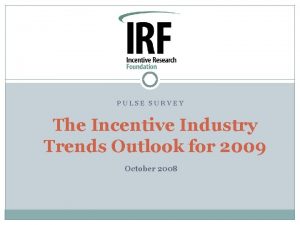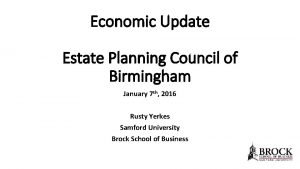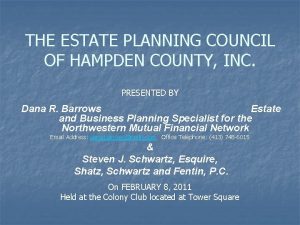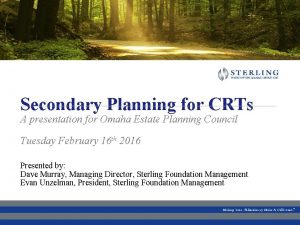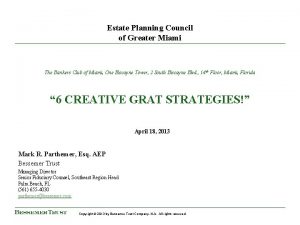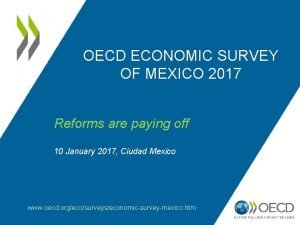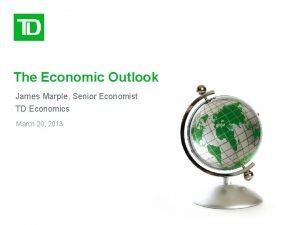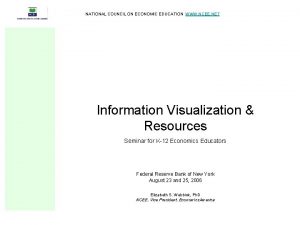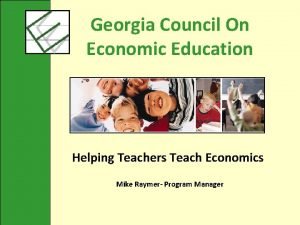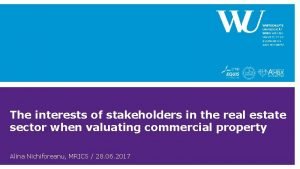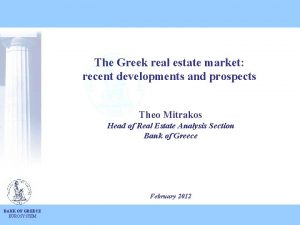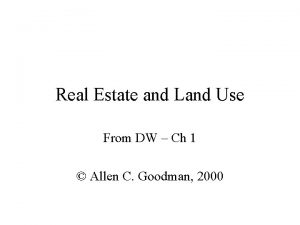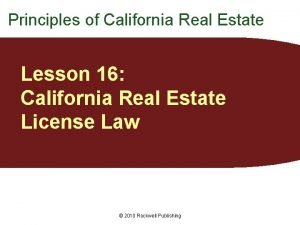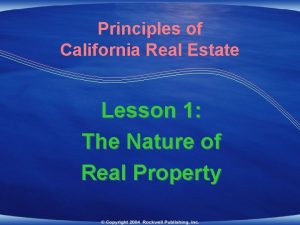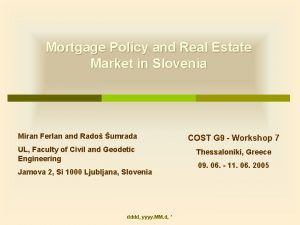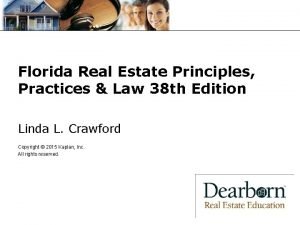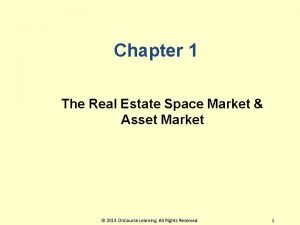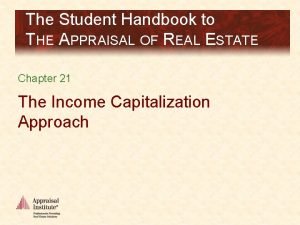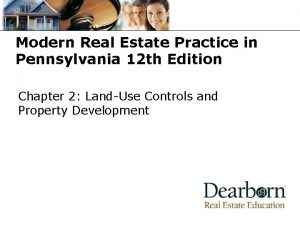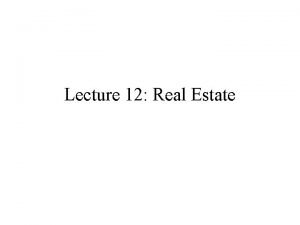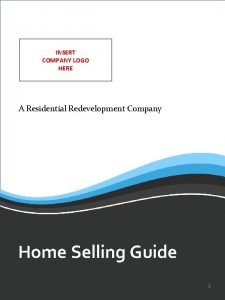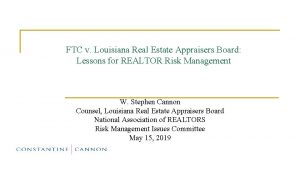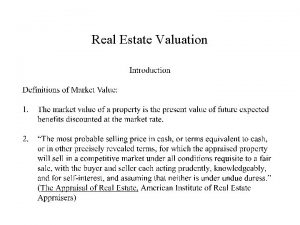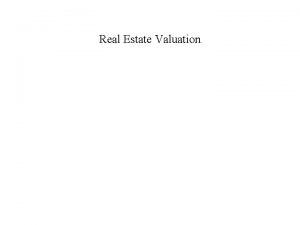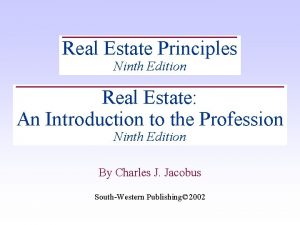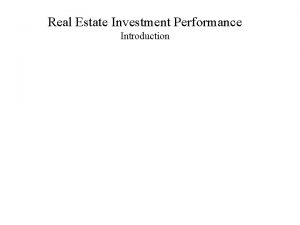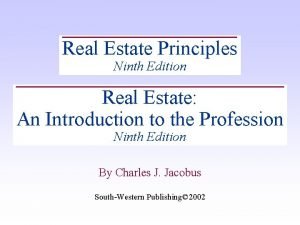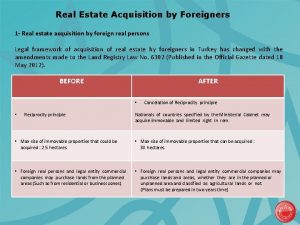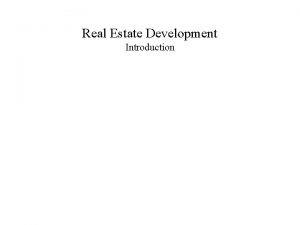Economic Outlook Chicago Real Estate Council Chicago IL
















































- Slides: 48

Economic Outlook Chicago Real Estate Council Chicago, IL January 19, 2017 William Strauss Senior Economist and Economic Advisor Federal Reserve Bank of Chicago

GDP expanded by 1. 7% over the past year

The Chicago Fed National Activity Index 3 -month average remains below zero

The Midwest economy has been growing close to trend, a bit better than the national economy

The real value of the stock market has reached new highs

The Federal Open Market Committee (FOMC) expects GDP to grow around trend over the next three years FOMC Central Tendency (December 2016) 2016 2017 2018 2019 1. 8 – 1. 9 – 2. 3 1. 8 – 2. 2 1. 8 – 2. 0 Longer run 1. 8 – 2. 0

The path of the current recovery is restrained compared with past deep recession recovery cycles average annualized growth: 4. 5% average annualized growth: 4. 3% average annualized growth: 2. 1%

Employment increased by 2. 16 million jobs in 2016

Illinois’ employment growth is well below the national average

The unemployment rate has fallen to 4. 7%

Illinois’ unemployment rate is well above the nation’s

The labor force participation rate fell to a level last seen in 1977

Civilian Labor Force Participation Rate and Population Share 16 and Older by Age Category, United States, 2007 and 2016 Labor Force Participation Rate (%) Population Share (%) Change 2016 2007 ‘ 07 -’ 16 Population 16 and older 62. 8 66. 1 -3. 3 100. 0 16 to 24 25 to 34 35 to 44 45 to 54 55 to 64 65 plus 55. 2 81. 6 82. 4 80. 0 64. 1 19. 3 59. 4 83. 3 83. 8 82. 0 63. 8 16. 0 -4. 2 -1. 8 -1. 3 -2. 0 0. 3 3. 3 15. 2 17. 2 15. 7 16. 3 18. 9 16. 1 17. 1 18. 3 18. 8 14. 0 15. 6 -1. 0 0. 0 -2. 6 -2. 1 2. 3 3. 3

The share of those unemployed more than 6 months remains significantly high

Employees working part time for economic reasons remains somewhat elevated

Wages and benefit costs continue to increase at a very slow pace

The FOMC forecasts that the unemployment rate will be just below the natural rate through 2019 FOMC Central Tendency (December 2016) 2017 2018 2019 4. 5 – 4. 6 4. 3 – 4. 7 4. 3 – 4. 8 Longer run 4. 7 – 5. 0

Slow productivity growth helps explain why relatively strong employment growth has not translated into higher wages

A large part of the weakness in productivity growth has been the weak pace of investment

Inflation is low, but moving higher

In large part inflation has been kept low due to the collapse of energy prices

Natural gas prices have also declined and remains low

Expenditures on energy are well below the historical average

Removing the volatile food and energy components from the PCE, “core” inflation remains low

The FOMC anticipates that PCE inflation will be around their two percent target over the next three years FOMC Central Tendency (December 2016) 2016 2017 2018 2019 1. 5 1. 7 – 2. 0 1. 9 – 2. 0 – 2. 1 Longer run 2. 0

The FOMC anticipates that “core” PCE inflation will reach two percent by 2018 FOMC Central Tendency (December 2016) 2016 2017 2018 2019 1. 7 – 1. 8 – 1. 9 – 2. 0

Blue Chip International Consensus Forecasts

Manufacturers’ Purchasing Managers Indexes

Over the past couple of years, the real trade-weighted dollar increased by 22%

Manufacturing output is flat compared with a year earlier

The Midwest Economy Indexes manufacturing component is near its trend and doing relatively better than the nation

Industrial production is forecast to improve but expand at a pace below its historical rate

Industrial vacancy rates are much lower in the Chicago area

Office vacancy rates are higher in the Chicago area

Office vacancy rates around the country are much higher in the suburbs

The same is true for the Chicago market

Why do you build homes? You build homes for people

There is a very close relationship between household formation and housing starts, but housing starts tend to be above household formation Housing starts (average) 1, 438, 000 per year New households (average) 1, 176, 000 per year

The amount of excess housing units compared with trend has disappeared +2, 947, 000 units -5, 301, 000 units 2, 947, 000 units -5, 352, 000 units -2, 405, 000 units

Since 1990, household formation growth has averaged one percent

Household formation remains below its long-run average 2, 367, 000 units -3, 345, 000 units +2, 367, 000 units -978, 000 units -3, 345, 000 units

Looking at the relationship between housing starts and household formation shows a large excess amount of inventory on the market, although it has begun to fall 3, 648, 000 units -2, 735, 000 units 913, 000 units +3, 648, 000 units -2, 735, 000 units

The forecast calls for a very gradual recovery in housing

Rental vacancy rates have been moving lower

Monetary policy has been very aggressive, keeping the Fed Funds near zero since December 2008

The Federal Funds Rate is expected to reach the neutral rate at the end of 2019 FOMC Central Tendency (December 2016) 2017 2018 2019 1. 1 – 1. 6 1. 9 – 2. 6 2. 4 – 3. 3 Longer run 2. 8 – 3. 0

Summary • The outlook is for the U. S. economy to expand at a pace around trend through 2019 • Employment growth is expected to slow with the unemployment rate remaining below the natural rate • Disappearing slack in the economy will lead to a gradual rising inflation rate • Light vehicle sales are anticipated to edge lower • The housing market is expected to continue improving through 2017

www. chicagofed. org www. federalreserve. gov
 Chicago estate planning council
Chicago estate planning council 11245 lantern road fishers in 46038
11245 lantern road fishers in 46038 Outlook incentive outlook
Outlook incentive outlook Estate planning council of birmingham
Estate planning council of birmingham Montgomery county estate planning council
Montgomery county estate planning council Omaha estate planning council
Omaha estate planning council Bankers club miami
Bankers club miami Oecd economic outlook
Oecd economic outlook James marple
James marple Council for mutual economic assistance
Council for mutual economic assistance Council for mutual economic assistance
Council for mutual economic assistance National council for economic education
National council for economic education Georgia council on economic education
Georgia council on economic education Realtor elevator pitch
Realtor elevator pitch Kwueval
Kwueval Real estate stakeholders
Real estate stakeholders Greek real estate market
Greek real estate market Sandy miller realtor
Sandy miller realtor Littoral rights definition
Littoral rights definition What are the 4 types of real estate
What are the 4 types of real estate Financial investment analysis
Financial investment analysis Strategicerp-real estate erp software
Strategicerp-real estate erp software 4 quadrant model real estate explained
4 quadrant model real estate explained Involuntary alienation in real estate
Involuntary alienation in real estate Blind ad real estate
Blind ad real estate Emblements real estate
Emblements real estate Manoj chatlani
Manoj chatlani Encumbered real estate
Encumbered real estate Features of industrial park
Features of industrial park Irs audit real estate professional
Irs audit real estate professional Real property definition
Real property definition Florida real estate principles practices & law
Florida real estate principles practices & law Florida real estate broker's guide
Florida real estate broker's guide Florida real estate broker's guide
Florida real estate broker's guide Space market vs asset market
Space market vs asset market Erp for real estate developers
Erp for real estate developers Arizona real estate law book
Arizona real estate law book Millionaire real estate investor worksheets
Millionaire real estate investor worksheets Real estate buyers packet
Real estate buyers packet Tucker kelley
Tucker kelley The student handbook to the appraisal of real estate
The student handbook to the appraisal of real estate Conclusion of real estate management system
Conclusion of real estate management system Urban economics and real estate markets
Urban economics and real estate markets Haji real estate
Haji real estate Modern real estate practice in pennsylvania 14th edition
Modern real estate practice in pennsylvania 14th edition Modern real estate practice in illinois
Modern real estate practice in illinois Real estate lecture
Real estate lecture Thanandpaul.com real estate
Thanandpaul.com real estate Louisiana board of appraisers
Louisiana board of appraisers


